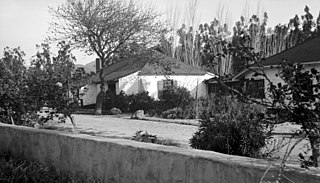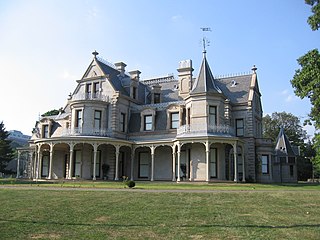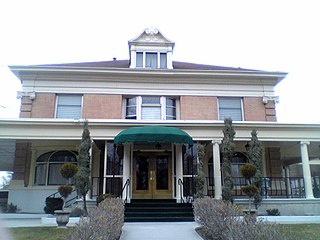
Santa Barbara is a coastal city in Santa Barbara County, California, of which it is also the county seat. Situated on a south-facing section of coastline, the longest such section on the West Coast of the United States, the city lies between the steeply rising Santa Ynez Mountains and the Pacific Ocean. Santa Barbara's climate is often described as Mediterranean, and the city has been dubbed "The American Riviera". According to the 2020 U.S. Census, the city's population was 88,665.

The Los Alamos Ranch House is a historic adobe house near Los Alamos in northern Santa Barbara County, California. The house, the centerpiece of Rancho Los Alamos, was built about 1840, and is one of the best-preserved examples of domestic architecture from California's Mexican period. The building was designated a National Historic Landmark in 1970.

Hope Ranch is an unincorporated coastal suburb of Santa Barbara, California, located in Santa Barbara County. It is bounded on the east by Santa Barbara, on the north and west by the unincorporated area of Noleta, and on the south by the Pacific Ocean. As of the 2000 census, the area had an approximate population of 2,200. The ZIP codes are 93105 and 93110, and the community is in area code 805.

Rancho Camulos, now known as Rancho Camulos Museum, is a ranch located in the Santa Clara River Valley 2.2 miles (3.5 km) east of Piru, California and just north of the Santa Clara River, in Ventura County, California. It was the home of Ygnacio del Valle, a Californio alcalde of the Pueblo de Los Angeles in the 19th century and later elected member of the California State Assembly. The ranch was known as the Home of Ramona because it was widely believed to have been the setting of the popular 1884 novel Ramona by Helen Hunt Jackson. The novel helped to raise awareness about the Californio lifestyle and romanticized "the mission and rancho era of California history."

The Lockwood–Mathews Mansion is a Second Empire style country house in Norwalk, Connecticut. Now a museum, it was built in 1864-68 for railroad and banking magnate LeGrand Lockwood. The 62-room 44,000 square feet (4,100 m2) mansion was listed on the National Register of Historic Places and was declared a National Historic Landmark in 1978.

Santa Barbara Senior High School, "Home of the Dons," is situated on a sprawling 40-acre (160,000 m2) campus in Santa Barbara, California in the Santa Barbara Unified School District. Among the oldest high schools in California and one of five high schools in the District, Santa Barbara High School was established in 1875 at the corner of Anapamu and De La Vina, but relocated to its present Upper Eastside site in 1924. Today, Santa Barbara High School has a diverse, near 65% minority enrollment of over 2000 pupils, 92 full-time teachers, and small learning academies, including Visual Arts and Design (VADA), Computer Science (CSA), and Multimedia Arts and Design (MAD). The school also features a performing arts department that employs professional designers, choreographers, musical directors and guest artists.

The Stow House is a U.S. historical landmark in Goleta, California. Formerly the headquarters of Rancho La Patera, the Stow House, in the Carpenter Gothic style, is now the headquarters of Goleta Historical Society which preserves and interprets the history of the Goleta Valley.

The Hinds House is a historic building in Santa Cruz, California. It was built in 1888 and 1889 by Alfred J. Hinds and his wife Sarah. Its Victorian style has been preserved and it is the largest surviving Stick-Eastlake house in Santa Cruz County. Today the Hinds House is a historical inn with rooms rented out to guests visiting or relocating to Santa Cruz.

The history of Santa Barbara, California, begins approximately 13,000 years ago with the arrival of the first Native Americans. The Spanish came in the 18th century to occupy and Christianize the area, which became part of Mexico following the Mexican War of Independence. In 1848, the expanding United States acquired the town along with the rest of California as a result of defeating Mexico in the Mexican–American War. Santa Barbara transformed then from a small cluster of adobes into successively a rowdy, lawless Gold Rush era town; a Victorian-era health resort; a center of silent film production; an oil boom town; a town supporting a military base and hospital during World War II; and finally it became the economically diverse resort destination it remains in the present day. Twice destroyed by earthquakes, in 1812 and 1925, it was rebuilt after the second one in a Spanish Colonial style.

The San Dimas Hotel, also known as Walker House, the Carruthers Home, and the San Dimas Mansion, is a historic structure in San Dimas, California, built by the San Jose Ranch Company in 1887. Originally built as a hotel, the 15,000-square-foot (1,400 m2) structure had 33 rooms and 14 fireplaces. The hotel was built in anticipation of a land boom that never happened, and it never had a paying guest. In 1889, the property was sold to James W. and Sue Walker for $25,000. After being occupied by seven generations of Walkers, the property was turned into a restaurant in 1979. The building became vacant in 1997 and was later acquired and renovated by the City of San Dimas. It was listed on the National Register of Historic Places in 1972.

Camarillo Ranch House, also known as Rancho Calleguas and Adolfo Camarillo House, is a Queen Anne-style Victorian house in Camarillo, California. Built in 1892, the 6,000-square-foot (560 m2) house was designed by architects Herman Anlauf and Franklin Ward. Adolfo Camarillo operated the ranch for 78 years, changing the operations from mostly cattle to crops. He was a leading innovator, growing lima beans, barley, corn, alfalfa, walnuts, and citrus and eucalyptus trees. The house was added to the National Register of Historic Places in 2003.
Rancho Las Positas y La Calera was a 3,282-acre (13.28 km2) Mexican land grant in present-day Santa Barbara County, California. The grant consisted of two parts:- "La Calera" given in 1843 by Governor Manuel Micheltorena to Narciso Fabregat, and "Las Positas" given in 1846 by Governor Pío Pico to Thomas M. Robbins. The grant was the northwest of the pueblo and Presidio of Santa Barbara, and encompassed the present day Hope Ranch, Hidden Valley, and Campanil neighborhoods.

Bembridge House, also known as Green-Rankin-Bembridge House, is a registered historic building located across from Drake Park in the Willmore neighborhood of Long Beach, California. The ornate and well-preserved Queen Anne Victorian house was built in 1906. Musician and school teacher Dorothy Bembridge lived in the house from 1918 until she was murdered there in 1999. The house was acquired by Long Beach Heritage in 2000.

Peter Josiah Barber was an American carpenter, architect, and prominent citizen of Santa Barbara, California. A native of Ohio, he was drawn to California during the Gold Rush in 1852 and settled in Santa Barbara in 1869, where he established himself as the city's foremost architect and served as postmaster and for two terms as mayor. His works include the Arlington Hotel, the second County Courthouse, and the original Santa Barbara Cottage Hospital, as well as several private houses. As mayor, he was also responsible for public works projects, most prominently the tree-lined boulevard, now called Cabrillo Boulevard, at East Beach. Three of the buildings he designed are listed on the National Register of Historic Places.

The Jesse Knight House, also known as the Knight Mansion, is a historic house in Provo, Utah, United States built for Jesse Knight. It was built in 1905, and added to the National Register of Historic Places in 1982. This home was designated to the Provo City Historic Landmarks Register on June 19, 1996.

The Bayview Opera House, formerly known as South San Francisco Opera House, is a theatre at 4705 3rd Street in Bayview-Hunters Point district, San Francisco. Founded in 1888, it is reputed to be the oldest existing theatre in the city. From 2014 to 2016, the theatre underwent renovation.
Edwards and Plunkett was an American architectural firm active between 1925 and 1940 in Santa Barbara, California. It was founded by William Albert Edwards (1888–1976) and James Joseph Plunkett (1900–1946), who were among the most famous practitioners of the Spanish Colonial Revival style in Santa Barbara. From 1926 to 1928, Henry Ward Howell (1889–1962) was a junior partner, and they operated as Edwards, Plunkett, and Howell. Their works include the Arlington Theatre, the Janssens–Orella–Birk Building, and the original terminal building of the Santa Barbara Municipal Airport.

The Superior Court of California, County of Santa Barbara, also known as the Santa Barbara County Superior Court or Santa Barbara Superior Court, is the branch of the California superior court with jurisdiction over Santa Barbara County.




















